| 1 | Europe’s main forest snake |
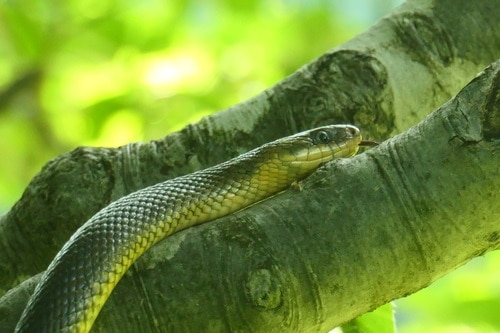
France has 12 species of snake, while Italy hosts 21. Some are viciously venomous, like the asp viper, while others are shy, humble creatures found in bushy hillsides, like the false smooth snake. Meanwhile, the snake in southern Europe most likely to be found in dark forests is the Aesculapian snake, AKA Zamenis longissimus. This is the most tree-dwelling (arboreal) snake in all of Europe. Aesculapian snakes swap between ground and branches, where they’re capable of reaching 4-5 metres high, probably more, in their quest to raid birds’ nests.
This is a non-venomous constrictor, with powerful and efficient squeezing abilities. Aesculapian snakes are widespread, inhabiting northern Spain, the lower 50% of France, all of Italy, southeast Austria, and pretty much every Balkan country (Albania, Macedonia). They’re also Europe’s third longest snake. The average is 140-160cm, with males being longer than females, but the longest of all time hit 2.25 metres.
Aesculapian snakes were named after the Greek god of healing, Asclepios, who inspired numerous healing temples across Europe 2000 years ago, with many surviving as crumbling stone ruins. Aesculapian was also the origin of the word “aesthetic”, due to his well honed physique on statues. This snake also exists in grassland next to forests, sparser woodlands, crumbling stone ruins, and even suburban Rome.
| 2 | Spews blood from its mouth |
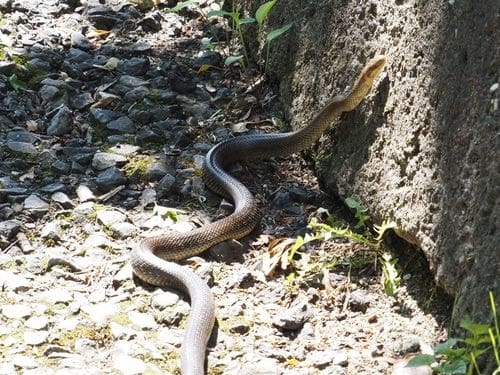
Aesculapian snakes are a slow and steady climber, grinding their way up tree trunks using instincts honed over millions of years. Like the US corn snake, they have adaptions such as keeled belly scales, which give them leverage for gripping gnarly fissures in bark. An Aesculapian snake could easily land on your head in a forest near Rome, but there’s little risk if they do. They aren’t complete cowards, and bite occasionally, but unlike the nearby horseshoe whipsnake, their fangs aren’t especially powerful.
Aesculapian snakes do have a few tricks up their sleeves. In May 2009, scientists found an Aesculapian snake by a road in Romania’s Latoriţa Valley. The scientists kept hold for 20 minutes, as the local shepherds were trying to kill the snake. At first, the Aesculapian snake attempted to escape, by wriggling and thrashing. Gradually, it calmed down, until suddenly, blood began trickling from its nose and lips.
The scientists hadn’t manhandled or injured the snake, yet the blood flow was maintained for 2-3 minutes. Then the Aesculapian snake attempted to fake death, by slackening its muscles and going limp. When the scientists set it down, the Aesculapian snake reactivated, but then noticed the scientists and went completely limp again.
This bleeding trick is called “autohaemorrhaging” and has also been spotted in the European dice snake. It’s an occasional part of the play dead repertoire of snakes worldwide.
| 3 | Invasive in the UK |
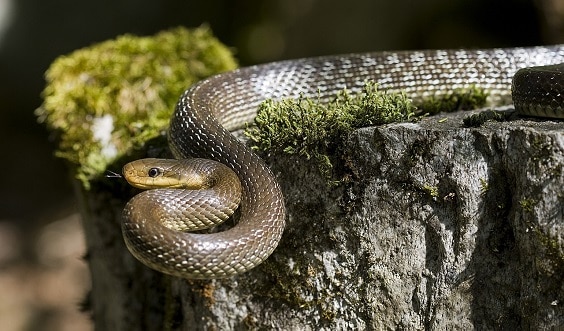
The UK has 3 native snakes as of 2024: the grass snake, adder, and rare smooth snake. But Aesculapian snakes are also found in 3 small locations due to accidental escapes. One is in North Wales, in Colwyn Bay, which not so coincidentally, lies close to the nearby Welsh Mountain Zoo. This population was established in the 1960s and still survives.
The second is in London’s Regent Canal, a heavily urbanised zone. Harried shoppers with bags of vegetables have been shocked for years now by Aesculapian snakes poking their heads out of cracks in concrete walls. It’s estimated that 40 survive, after first being spotted in the 1980s. Authorities are taking no action, as this urban population is forecast to die off naturally. As they prey mainly on rodents, they’re believed to be having no negative ecological consequences.
The most recently discovered colony lies in southern Wales, near Bridgend. In 2016, a confused resident asked scientists for help with a mystery snake found in their garden. The scientists then found several more Aesculapian snakes lurking in nearby allotments, possibly using the railway line as an artificial travel corridor. This South Wales colony was estimated to be 15-20 years old.
| 4 | Comfortable in urban zones |
Aesculapian snakes are an expert at using human environments to their advantage. They lay eggs in spots like hay stacks, piles of leaves and saw mill waste, usually in batches of 5-11, measuring each 6 by 2.5 cm. Compost or manure piles are a particular favourite, due to the winter warmth they maintain. In Hessel, Germany, one manure heap contained 2000 snake eggs, from both the Aesculapian snake and grass snake.
They’re also relatively intelligent about roads. A 2014 study examined a road in northwest Bohemia, Czech Republic. Aesculapian snakes lived on either side, on the embankments and adjacent stone walls. Yet it was very rare for adults to stray onto the concrete itself, where screeching tyres could kill them. They used water culverts as a passage underneath instead. The adults kept their cool, and didn’t even react to passing traffic. Juvenile Aesculapian snakes were more reckless and did sometimes become roadkill.
Aesculapian snakes are diurnal rather than nocturnal. They tend to avoid activity at midday, favouring early morning, and late afternoon from 16:00-19:00.
| 5 | The isolated German pockets |
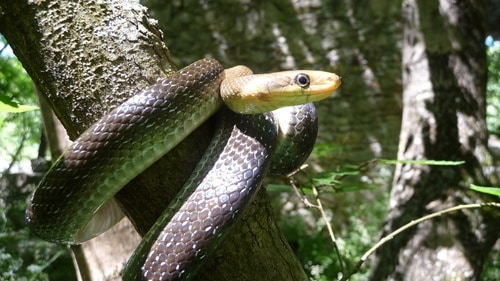
One quirk about the Aesculapian snake is the remnant northern pockets it has. There’s a pretty much continuous empire covering lower France, Italy, the Balkans, etc. Yet away from the main range, there’s a handful of completely isolated populations, 2 in western Germany, one in southern Germany, a few in Poland and another in the Czech Republic.
These are separated from the main territory by hundreds of miles, and live in a significantly cooler overall climate. They only cling to unusually warm spots, typically humid, wooded valleys with a stream running through the centre. For centuries, these were thought to be artificial introductions by the Romans, who constructed healing spas worshipping Asklepios, or a travelling Greek merchant named Avramides. But these theories are false – they’re actually remnants from a time when their empire was larger.
The story started during the Last Glacial Maximum about 20,000 years ago. These were the darkest days for reptiles in Europe. Snow, ice and woolly rhinos covered the land, and most snakes were pushed back to warm refuges in southern France, Spain and the Balkans.
| 6 | Ice age origins |
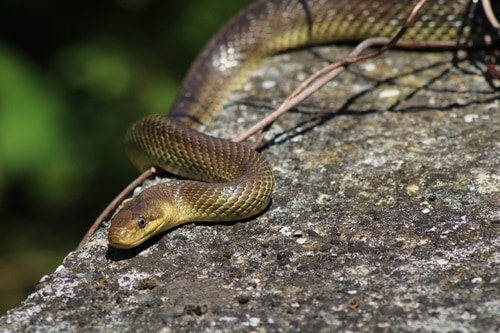
Gradually, ice sheets retreated, until 5000-8000 years ago, Europe reached the Holocene maximum, the warmest point in living memory. Temperatures were 2-2.5C above the present, and even pond turtles reached Sweden. Likewise, snakes reached far further north than today. Aesculapian snakes may have artificially invaded Britain recently, but 6,000 years ago, they were there naturally, as proven by fossils found in Cudmore Grove, an estuary fossil deposit in Essex, and Beeches pit in Sussez.
Likewise, snake bones were found in Denmark in the Maglehøj burial mound, alongside magical artefacts like the larynx of a raven and two small quartz pebbles. The mound dated back to the bronze age (3300-1200BC), and the 15 vertebrae were concluded to be from an adult Aesculapian snake measuring 1.2 metres. One Danish fossil dates back to 6000 years ago.
Of course, these glory days had to end. The climate cooled again, not to fully-fledged ice age levels, but enough to bring back snowy winters and force snakes to gradually retreat southwards. This process has been continuing in the thousands of years ever since. Aesculapian snakes died out in the UK, the low countries and most of Germany, but pockets survived in certain microregions. Some extinctions were relatively recent. There was a colony in Denmark in the 1700s, which was last officially observed in 1863, on the island of Sjæland. Basel, Switzerland hosted Aesculapian snakes until 1971.
| 7 | The northern invasion |
Today, there are 4 main surviving pockets of the glory Holocene days. Schlangenbad, west Germany, Hirschhorn in western Germany, Burghausen in Bavaria, and Ohře river valley in the Czech republic. Most live in near sheltered wooded streams, and all 4 are endangered by encroaching agriculture and housing estates.
Recently, scientists discovered more details on how exactly they conquered the north, 8000 years ago. They analysed Aesculapian snakes from all over Europe, and found deep genetic separation. There were two genetic groups, or clades: a western group in Italy and France, and an eastern grouping in the Balkans. There was also an Asian group in the extreme east, and a small Greek clade in Greece and the Adriatic coast.
By testing the surviving German and Czech pockets, they concluded that it was the eastern clade that spread northwards after ice sheets retreated. For some reason, the western Aesculapian snakes in southern France stayed put and never got moving. The UK and German versions all originated from those in eastern and central Europe. The Greek clade also failed to migrate northwards. Today, the German colonies are more closely related to those from Bulgaria or Romania.
| 8 | Diet: mammals with some lizards |
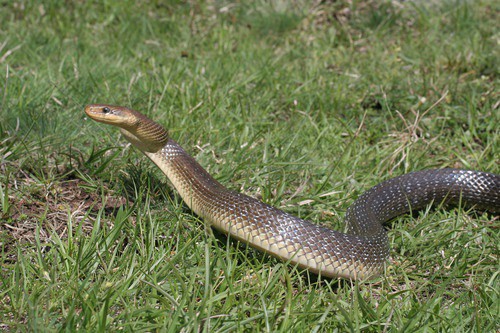
Aesculapian snakes primarily feed on mammals, with a secondary helping of lizards and birds, which they pluck directly from nests. A 2009 study examined Aesculapian snakes from 3 locations in central Italy, including the Tolfa mountains and a forest near Oriolo Romano. Mammals dominated in each location, with top species including the house mouse and bank voles. The top reptile was the common wall lizard (Podarcis muralis), and no amphibians were recorded. Bird prey included the common blackbird.
Then the Aesculapian snake was compared side by side with another common Italian species, the horseshoe whipsnake. Their diets clearly differed, with the horseshoe whipsnake focussing on lizards, and Aesculapian snakes mainly eating mammals. Horseshoe whipsnakes ate just 1 type of bird, versus 5 types. The Aesculapian snake’s favourite prey included bank voles and wood mice, while horseshoe whipsnakes favoured western green lizards and common wall lizards. The sample size was strong, with 295 prey found in horseshoe whipsnakes and 182 in Aesculapian snakes.
Finally, a study compared the two neighbours again, this time in suburban Rome, where local colonies had clung on. The sample size was lower, but the story was similar. Aesculapian snakes ate mammals exclusively, all of which were Norwegian rats. The horseshoe whipsnakes ate one Norwegian rat, but preferred lizards, particularly the western green lizard. Aesculapian snakes have their own mammal niche which they control when they live alongside other snakes.
| 9 | Europe’s main bat-eating snake |
Aesculapian snakes take their mammal obsession far and wide, and become one of the few European snakes to eat bats. The first observation happened in Albania’s Prespa National Park in 2014. 50 metres deep in a cave, where the roof was 3 metres high, an Aesculapian snake was spotted eating a common bent-wing bat (Miniopterus schreibersii), using its exceptional climbing skills on rocky walls rather than tree bark this time.
The next setting was Orlova Chuka Cave in Bulgaria’s Rusenski Lom Nature Park. This was a truly epic bat cave, with 10,000 individuals across 15 species. This time the Aesculapian snake was by the entrance, waiting for a furious, flapping exodus of bats at night. It was in a hole in the rocky wall, 1.3 metres above ground, with just the upper third of its body poking out. The Aesculapian snake successfully caught a greater mouse-eared bat, and struggled for 30 minutes to swallow, having particular trouble getting past the wing. Once it succeeded, the Aesculapian snake retreated into the wall, like an eel.
These observations also confirmed at once that the Aesculapian snake is a lover of caves. Or maybe it dislikes caves, but the smell of the bats inside is too irresistible.
| 10 | Round pupils and buzzing tails |
While Aesculapian snakes are flexible in their habitats, they have a few basic requirements. Firstly, they need humidity. They never appear in dry Mediterranean bushland, and in Spain, they avoid the hotter, drier southern areas.
Another defensive trick of the Aesculapian snake is vibrating their tail rapidly, to make a buzzing noise against leaf litter. Originally, this species was part of the large Elaphe ratsnake family (18 members), but was switched to the Zamenis family in 2002. This has 6 members in total, also including the Spanish ladder snake and Greek leopard snake. Aesculapian snakes have round pupils, and a head which is barely distinct from the neck (unlike a viper’s triangular head). Females and males are nearly identical in colour.
There’s also an enduring mystery surrounding Aesculapian snakes. For years, it was assumed that the carved snake in Asklepios’ rods in all those statues was this species. Likewise for the Roman healing temples, where sick patients were ordered to lie on a stone floor, while snakes slithered all around and over them for 8 hours at night. But more recent scholars have concluded that this was actually the four-lined snake, also common in Italy. The species’ entire name may be a mistake.
